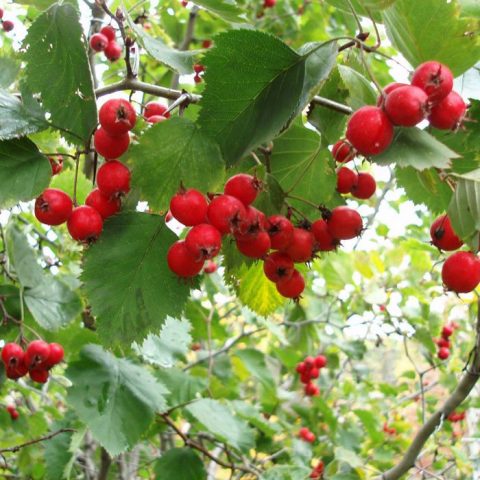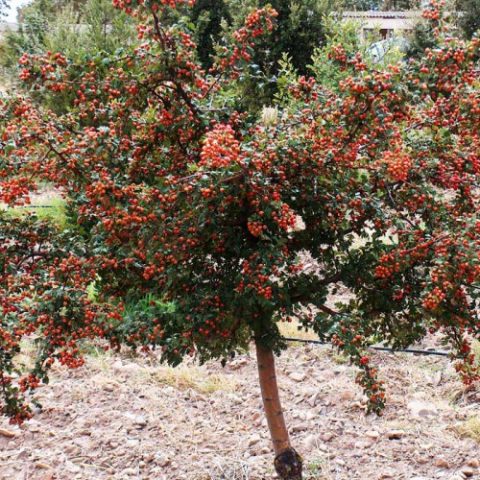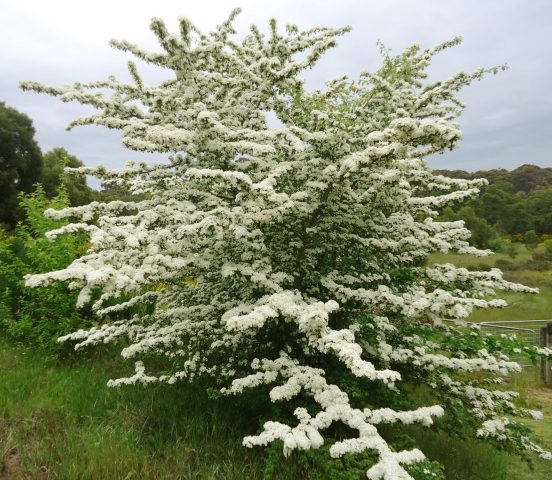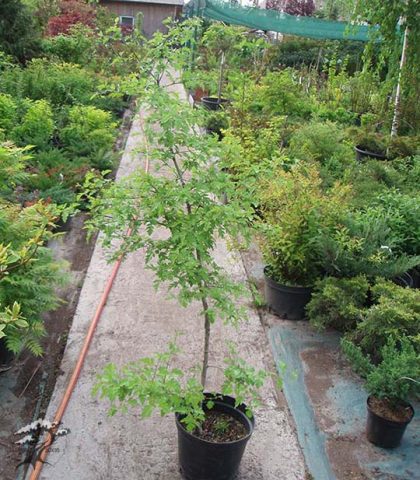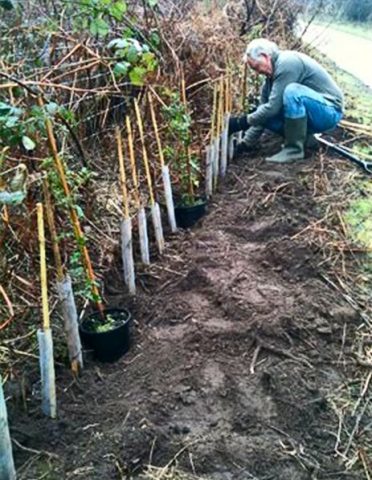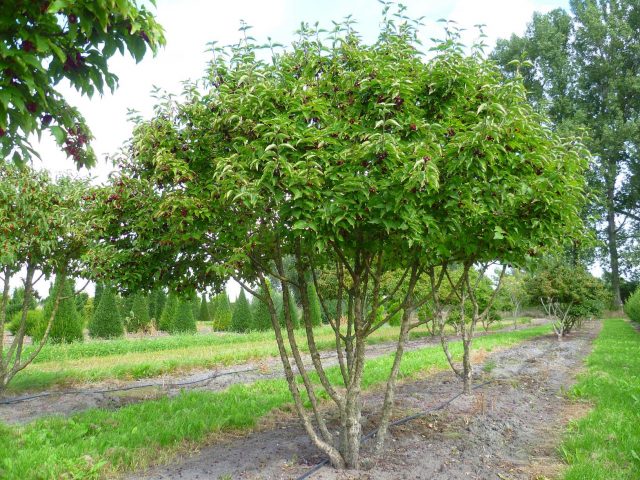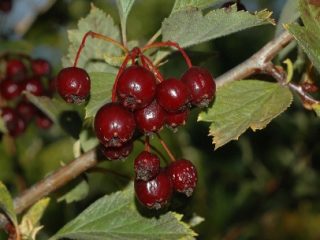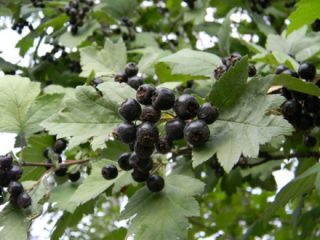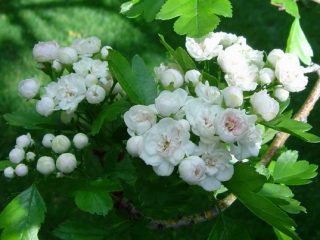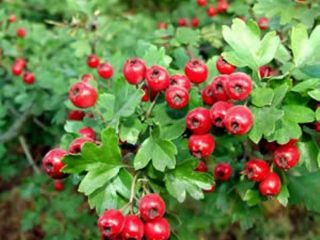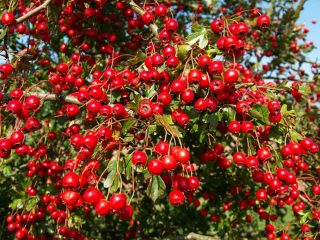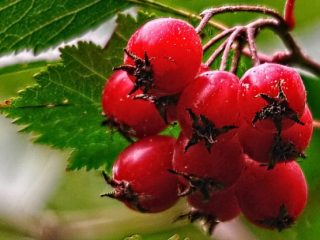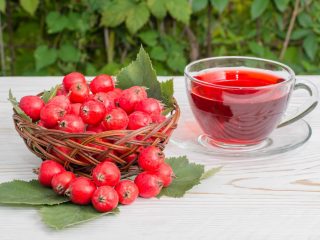Content
Hawthorn monopistil is a representative of the Hawthorn genus of the Rosaceae family. The specific name translated means “strong”. And for good reason, since the plant really has durable wood. Perhaps this indicates the longevity ability of the hawthorn variety monopistillate. The officially recorded life expectancy of this culture is 200-300 years.
History of selection
In the natural environment, single-pistillate hawthorn (lat. Crataegus monogyna) grows in Moldova, Ukraine, the Carpathians, Crimea, the North-West Caucasus, the Baltic states, and the European part of Russia. It has been spotted in Western European countries. For full growth, it selects areas near rivers, dry oak forests, on the edges; less commonly, the single-pistillate hawthorn is found in pine-deciduous forests, on rocky slopes, and sandy soils.Can grow singly or in groups of shrubs.
Description of hawthorn unicornus
Hawthorn monopistillate belongs to the category of ornamental shrubs and trees. Botanical features of the plant.
- Height 4-6m, under favorable conditions perhaps higher.
- The crown is dense, openwork, symmetrical, 2 m wide.
- Old shoots are bare, young shoots are densely hairy. There are a few spines up to 1 cm long, which are often absent.
- The bark of the branches is reddish-gray and peels off. The trunk is straight.
- Foliage is 2-3 cm long and 1-2.5 cm wide. The shape is ovoid or oval, asymmetrical, with entire lobes. Several teeth are visible at the top of the leaf.
- Stipules are thin. The petiole is ½ the length of the leaf.
- In summer, the foliage is leathery, dark green with a glossy sheen. In the autumn season it is colored red and orange.
- The fruits of hawthorn monopistillate are spherical, red, less often yellow. Their length is 6-10 cm. Inside there is a bone measuring 7x5 mm.
- The inflorescences are large, 10-18 flowers each.
- .Sepals are triangular-lanceolate in shape. There are 20 stamens, red anthers.
- The diameter of the flowers is 1-1.5 cm. The petals are white.
Characteristics of the variety
Hawthorn varieties differ in crown shape, leaf color, texture and color of flowers. Among garden forms, the most common are:
- pyramidal - the plant has the shape of a pyramid;
- weeping - a bush with branches drooping downwards;
- crimson - with single dark red flowers;
- pink weeping - with pink inflorescences hanging down;
- pink – pink flower petals with white stripes;
- white terry - inflorescences of the corresponding color and texture;
- red terry;
- constantly blooming - a shrub that blooms throughout the summer;
- split-leaved - a plant with deeply dissected foliage;
- white-variegated – hawthorn with variegated leaves;
- thornless – shoots are devoid of thorns.
There are also new subspecies of monopistillate hawthorn obtained by hybridization. A striking representative is the variety “Rosea Flore Pleno” with double flowers of dark pink color. An equally popular species is Stricta hawthorn. The tree has a colonial or oval crown shape. Used for landscaping in cramped urban environments.
Drought and frost resistance
The single-pistillate hawthorn variety easily tolerates sudden changes in temperature and air humidity. Able to grow successfully in places with a continental climate. For established shrubs there is no need for shelter in winter. However, young annual growth can freeze. Hawthorn easily tolerates drought and can survive without watering for a long time.
Productivity and fruiting
The flowering period of the monopistillate hawthorn variety begins in May-June. The fruiting period begins in September. The shrub is characterized by a regular, abundant harvest of fruits. Ripe hawthorn berries have a rich, persistent aroma, which, unfortunately, is not conveyed by the photo. They are edible.
Resistance to diseases and pests
The single-pistillate hawthorn variety often serves as a target for attack by harmful insects: aphids, copperheads, psyllids, weevils, and mites. Especially if it grows near orchards.However, the main enemy, which can cause significant harm to the plant, is hawthorn. The shrub can also suffer from fungal diseases.
Advantages and disadvantages
Judging by the reviews of amateur and professional gardeners, the main positive qualities of the monopistillate hawthorn variety include:
- ability to withstand low temperatures;
- grows in dry periods;
- undemanding to soil composition;
- good immunity;
- abundant fruiting;
- suitable for creating hedges;
- the fruits have medicinal properties;
- gives self-seeding.
Disadvantages of hawthorn:
- has a high shoot-forming ability, which means frequent trimming of the bush;
- frosting of young shoots is possible.
Landing Features
Hawthorn of the single-pistillate variety is a non-capricious plant in terms of planting and care. Can grow in any environment. Under properly selected conditions, the shrub gives moderate annual growth - 25 cm in length and the same in width.
Recommended timing
It is quite difficult to name the exact planting dates of the single-pistillate hawthorn variety. It all depends on the climatic characteristics of the region. The further south you go, the earlier the planting is carried out in the spring, and later in the fall.
It is necessary to monitor the condition of the shrub, that is, it cannot be planted when it is in the growing season. It is advisable to wait until the hawthorn is preparing for bed. In general, decorative crops do not require special weather conditions; it is enough that the soil warms up slightly in the spring and does not freeze in the fall.
Selecting a suitable location and preparing the soil
According to experienced gardeners, it is preferable to place a single hawthorn of the single-pistillate variety in partial shade or in areas with diffuse lighting. The scorching rays of the sun can cause thermal burns to the leaves. A hedge requires dense planting, where each plant will compete with its neighbor for light. As a result, the bushes will begin to grow on all sides. In group plantings, single-pistillate hawthorn is planted at a distance of 2-5 m, and in alley plantings - 5-6 m on an open, sunny plantation.
Soil in this context does not matter. Any environment will do, even sandy and rocky soils. However, when planting in obviously poor soils, fertilizers must be added to the hole: humus and wood ash at the rate of 0.5 liters per 10 liters of soil. The preferred soil acidity is pH 7.5-8.
What crops can and cannot be planted nearby?
It is not the best combination of hawthorn of the single-pistillate variety with fruit trees, due to the negative mutual influence. For this reason, it is not recommended to plant the plant next to cherry plum, apple, pear, cherry, plum, apricot, and peach. Possible proximity to thorns, rose hips, and geranium.
Selection and preparation of planting material
Seedlings must first be well developed. Their size is chosen depending on the purpose and type of planting. For a two-row fence, young growth 1-1.5 m high is suitable; for a single-row wall, plants are taken a little higher. It is important that they have an equally developed root system and above-ground part. To plant free-standing trees, you will need larger planting material, above 2 m.
Immediately before the planting procedure, the long roots of the hawthorn monopistillate are trimmed, broken shoots are removed, the side branches and the top are shortened by ½ the length of the growth, aligning with the total length of the seedling.
Landing algorithm
When forming a recess and determining its dimensions, the following factor should be taken into account: the single-pistillate hawthorn has a fairly powerful, branched root system.
- First, prepare a pit 70-80 cm deep.
- In heavy soils that do not absorb water well, a drainage layer consisting of expanded clay, pebbles, and crushed stone is required. Provide a thickness of 10-15 cm.
- In addition to nutritional components (humus, manure, charcoal), 40 g of lime are added to the pit. Leave in this state for 7-10 days.
- A hawthorn seedling is placed in the middle of the recess and sprinkled with earth.
- The soil is not compacted.
- Warm water is poured over the top.
Aftercare
Hawthorn monopistillate does not require serious care. You only need to know the basic rules for the full development of the tree.
The shrub needs abundant watering during abnormal weather conditions, during periods of prolonged drought. And the rest of the time, it is worth moisturizing hawthorn monopistillate no more than once a month. In addition to watering, fertilizing will also affect the general condition of the plant, but not often. It is enough to fertilize the shrub 2 times a year: in March before the buds appear and in May-June during flowering. In the spring, it is preferable to apply a solution of nitrophoska, and in the summer - organic fertilizers.
In addition to watering and fertilizing, the single-pistillate hawthorn variety will need regular pruning. In a well-lit area, the crown has the correct shape.Therefore, only a preventive procedure should be carried out annually, removing dry, broken, unhealthy-looking branches. Remove faded inflorescences. Anti-aging pruning should be performed on bushes that are already more than 6-7 years old. To do this, cut off the old 2-3 branches. New shoots will appear in this place next year and will bear fruit. If the hawthorn bush has a too dense appearance, then the internal branches need to be cut out to increase the light inside the plant and the yield.
Despite the fact that the single-pistillate hawthorn is a winter-hardy plant, it can freeze at temperatures of 35-40 °C and particularly long frosts. To prevent this from happening, you need to cover the trunk with snow to the maximum height. If there is no snow, then you can wrap it in burlap.
Diseases and pests, methods of control and prevention
You can get rid of annoying insects with an insecticide solution; fungicide preparations will help with fungal diseases. However, in order to maximally protect hawthorn from negative consequences, you should resort to regular preventive measures:
- pruning dry branches;
- collecting fallen leaves;
- treatment of shrubs with folk remedies;
- deletion weed;
- loosening the surface layer.
Application in landscape design
Single-pistillate hawthorn is used for group and individual plantings. Suitable for constructing hedges of different heights, landscaping garden plots, city parks, alleys.This unpretentious plant can be easily shaped into any shape as it responds well to pruning. The aesthetic beauty of landscape structures with monopistillate hawthorn is difficult to describe; you can only look at it in the photo, but it’s better to see it with your own eyes.
Conclusion
Hawthorn unicornus will decorate any garden. Even an inexperienced gardener will be able to cope with this shrub, because it does not require special care. Grows, blooms and bears fruit well in any conditions.
Reviews
